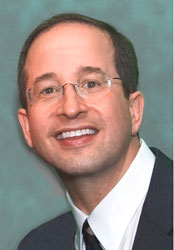Dr. Scott Miller of Georgia Urology
Listen to a recording of the show.
Dr. Scott Miller practices with Georgia Urology, the largest urology practice in Atlanta and the Southeast.
Dr. Scott Miller of Georgia Urology
Having arrived in Atlanta in 1995, Dr. Scott Miller of Georgia Urology was the first urologic laparoscopist in the state of Georgia. Specializing exclusively in laparoscopic and robotic urologic surgery, he performs approximately 300 procedures of this type annually. He actively develops new surgical techniques and shares his methods and results with surgeons around the world.
Dr. Miller graduated from the Medical College of Georgia and completed his urologic residency at the University of Kentucky Medical Center. During his training in the early 1990s, his residency program was one of the first centers to embrace advanced urologic laparoscopy techniques. Seeing the virtues of laparoscopy before it was widely accepted, he was one of the first urologists to perform these procedures in a large scale outside of an academic center. In 1995, Dr. Miller performed the first laparoscopic kidney removal for cancer in the state of Georgia. He later performed Georgia’s first laparoscopic prostate removal in 2000 and Georgia’s first robotic prostate removal in 2003. He was also the first in the state to perform complex reconstructive procedures of the urinary tract laparoscopically. He currently has one of the largest and most diverse experiences in laparoscopic and robotic urology in the Southeast.
Dr. Miller is an active member of many professional societies including the American Urological Association, the Society of Laparoendoscopic Surgeons, and the Endourological Society. He has been board-certified by the American Board of Urology since 1997. Dr. Miller is continually committed to the education of others through peer-reviewed journal and book chapter publications, hands-on teaching, and scientific presentations.
Show Notes
Major Health Headlines in 2011: Sources: New York Times, Time Magazine, NPR
Steve Jobs:
The public’s monitoring of his appearance and health and the reaction to his death were phenomenal. The world watched as he acknowledged his pancreatic cancer diagnosis in 2004.
Many used Apple products their whole life and have been deeply influenced by Steve Jobs, because he is so associated with his design. “The way he sort of dominates Apple means that it really feels like you’re having a conversation with him when you use the devices.”
Jobs denied conventional treatment and opted instead for homeopathic remedies as his cancer continued to progress.
In the soon to be released bio we learn about his early decision to put off surgery and rely instead on fruit juices, acupuncture, herbal remedies and other treatments — some of which he found on the Internet — infuriated and distressed his family, friends and physicians, the book says. From the time of his first diagnosis in October 2003, until he received surgery in July 2004, he kept his condition largely private — secret from Apple employees, executives and shareholders, who were misled.
Earthquake in Japan:
On March 11, 2011, an earthquake struck off the coast of Japan, churning up a devastating tsunami that swept over cities and farmland in the northern part of the country and set off warnings as far away the west coast of the United States and South America. Recorded as 9.0 on the Richter scale, it was the most powerful quake ever to hit the country. By July, the count of dead and missing was above 22,000.
As the nation struggled with a rescue effort, it also faced the worst nuclear emergency since Chernobyl; explosions and leaks of radioactive gas took place in three reactors at the Fukushima Daiichi Nuclear Power Station that suffered partial meltdowns, while spent fuel rods at another reactor overheated and caught fire, releasing radioactive material directly into the atmosphere. Japanese officials turned to increasingly desperate measures, as traces of radiation were found in Tokyo’s water and in water pouring from the reactors into the ocean.
- When do the health effects from radiation begin to manifest? What are the health effects?
- Depending on length of exposure and how much radiation is involved, the effect can be acute in the form of radiation poisoning, or more long term in the form of increased risk of cancers.
- The workers at the plant who were trying to cool overheated fuel rods and prevent a meltdown were likely to experience the highest levels of exposure in the shortest period of time. They are at highest risk for radiation sickness, or acute radiation syndrome, which can damage tissues, cause the bone marrow to stop generating new blood and immune cells, and lead to periods of severe illness or eventually death. People exposed to high levels of radiation are also at greatest risk of infection, so they need to be kept in isolation wards in sterile environments to protect them from bacteria and viruses.
- How far reaching is the contamination?
- The reports of hot spots do not indicate how widespread contamination is in the capital; more sampling would be needed to determine that. But they raise the prospect that people living near concentrated amounts of cesium are being exposed to levels of radiation above accepted international standards meant to protect people from cancer and other illnesses.
Obesity:
Nearly two-thirds of the United States population is overweight. There are many ways to determine if a person is overweight, but experts believe that a person’s body mass index (BMI) is the best way to assess an adult’s weight in relation to their height. The risk of death and disease is increased for adults who are overweight and obese.
- A BMI from 18.5 to 24.9 kg/m2 is considered normal.
- Adults with a BMI of 30 to 39.9 kg/m2 are considered obese.
- Adults with a BMI greater than or equal to 40 kg/m2 are considered extremely obese.
- Anyone more than 100 pounds overweight is considered morbidly obese.
Many environmental forces, from economic interests of the food and beverage industries to the way our cities and towns are built, have conspired to subvert the body’s natural ability to match calories in with calories out.
And the solution to the nation’s most pressing health problem — the ever-rising epidemic of overweight and obesity at all ages — lies in the answer to this question:
- Why did this happen in the first place?
- Television and less physical activity, energy requirements for daily life have decreased substantially with the advent of labor-saving devices and automobiles
- Convenience foods rich in sugar, salt and fat, substances that humans are evolutionarily programmed to crave.
- Americans are not known for resisting fast-food temptations, especially if money is tight.
- Low-income urban areas that lack stores that sell fresh fruits and vegetables
- What diseases are the result of being over-weight and obese?
- Cardiovascular disease, diabetes, hypertension, asthma, etc.
- There is evidence that cancer risk is affected by obesity
- Our nation’s high obesity rate affect the rising costs of healthcare
- Childhood obesity is a major problem. How will this continue to shape the healthcare landscape as these kids grow up?
- Researchers found a distinct correlation between higher childhood body mass index (BMI) and a greater risk of future heart disease and heart disease–related death.
Vaccines:
Since the 1990s, vaccines have become somewhat controversial, even in the United States. As diseases have disappeared, generations have grown up without ever seeing the sickness and death they caused. At the same time, new parents are often upset as their babies receive between 20 and 30 injections before age 2 and suffer the pain and mild fever that can accompany them as routine side effects.
The question of whether to mandate vaccination of preadolescent girls against HPV, or the human papillomavirus caught fire during a Republican debate in Texas last month, when Mrs. Bachmann, of Minnesota, and former Senator Rick Santorum of Pennsylvania attacked Texas governor Rick Perry, claiming that the decision to vaccinate children is best left to parents. Bachmann falsely claimed that the vaccine has been known to cause mental retardation.
- Why do we need vaccines?
- Immunizations help protect infants, children, and adults against many infections that used to be much more common.
Examples include tetanus, diphtheria, mumps, measles, pertussis (whooping cough), meningitis, and polio.
Newer immunizations protect children and adults against other types of meningitis, pneumonia, and ear infections.
Many of these infections can cause serious or life-threatening illnesses, and may lead to lifelong disabilities. Because of immunizations, all of these illnesses are now rare.
- Do vaccines cause mental illness, mental retardation, or autism?
- No. Rumors continue to spread that some vaccines, or a mercury antifungal vaccine preservative called thimerosal that was added to vaccines, cause autism. Numerous studies have shown no link between autism and either vaccines or the preservative.
- How do comments circulating in the media affect public health (i.e. buzz over Bachmann comment)?
- When politicians or celebrities raise alarms about vaccines, even false alarms, vaccination rates drop.
- In the case of the HPV vaccine use of the vaccine was disturbingly low even before the Bachmann flap, health officials say. That is partly because of the recent climate of fear about vaccines in general, and partly because some parents feel that giving the vaccine somehow implies that they are accepting or even condoning the idea that their young daughters will soon start having sex.
- Should girls and boys be vaccinated against HPV?
- The CDC recommended that boys ages 11 and 12 should be vaccinated. It also recommended vaccination of males ages 13 through 21 who had not already had all three shots. Vaccinations may be given to boys as young as 9 and to men between the ages of 22 and 26.
The committee recommended in 2006 that girls and young women ages 11 to 26 should be vaccinated, but vaccination rates in the United States have so far been disappointing.
The vaccine has been controversial because the disease it prevents results from sexual activity, and that controversy is likely to intensify with the committee’s latest recommendation since many of the cancers in men result from homosexual sex.
- For the public health experts, the vaccine’s remarkable effects are irresistible.
Drug shortages:
Federal officials and lawmakers, along with the drug industry and doctors’ groups, are rushing to find remedies for critical shortages of drugs to treat a number of life-threatening illnesses, including bacterial infection and several forms of cancer.
So far this year, at least 180 drugs that are crucial for treating childhood leukemia, breast and colon cancer, infections and other diseases have been declared in short supply — a record number.
Prices for some have risen as much as twentyfold, and clinical trials for some experimental cures have been delayed because the studies must also offer older medicines that cannot be reliably provided.
- Why is there a drug shortage?
- Drug shortages have tripled in the past six years. According to the FDA, 61 drug products were reported in short supply in 2005 and jumped to 178 by 2010—that doesn’t include shortages of vaccines, immune globulin products, and other biologics, or products made from blood, tissue, or other biological sources.
- A major reason for these shortages has been quality/manufacturing issues. However, there have been other reasons, such as production delays at the manufacturer, and delays companies have experienced receiving raw materials and components from suppliers. Discontinuations are another factor contributing to shortages. Changes in reimbursement from Medicare and insurances make some drugs cost more to make than is received in payment. When one company has a problem or discontinues a drug, it is difficult for the remaining firms to increase production quickly and a shortage occurs.
- How do I know if a drug I am taking is in short supply?
- There is a list posted on the American Society of Health System Pharmacists (ASHP) website along with additional information.
Healthcare Reform:
The health care law seeks to extend insurance to more than 30 million people, primarily by expanding Medicaid and providing federal subsidies to help lower- and middle-income Americans buy private coverage.
It will create insurance exchanges for those buying individual policies and prohibit insurers from denying coverage on the basis of pre-existing conditions.
To reduce the soaring cost of Medicare, it creates a panel of experts to limit government reimbursement to only those treatments shown to be effective, and creates incentives for providers “bundle’’ services rather than charge by individual procedure.
More than 20 challenges to some aspect of the sprawling act have been filed around the country, many put in motion by Republican governors and attorneys general. Most focused on the so-called individual mandate, a requirement that all Americans buy health coverage or pay a fine (or tax, depending on who is describing it). The insurance mandate is central to the law’s mission of expanding coverage, because insurers argue that only by requiring healthy people to have policies can they afford to treat those with expensive chronic conditions.
In February 2011, three district judges upheld the mandate and two found it unconstitutional. All those in favor had been appointed by Democrats, while those against had been chosen by Republicans.
Over the summer of 2011, three federal appeals courts weighed in. One found the mandate constitutional, one did not and one ruled that the plaintiffs, including the state of Virginia, had no standing to bring a challenge — a mix of opinions that all but guarantees a Supreme Court review.
The Cost of Healthcare:
In 2010, the United States spent $2.6 trillion on health care, over $8,000 per American.
If we continue at this rate of growth, health care will be roughly one-third of the entire economy by 2035 — one of every three dollars will go to health care — and nearly half by 2080. For more than 30 years, health care costs have been growing 2 percent faster than the overall economy.
- This level of spending on health care is high, but is it worth it? Does it make us healthier?
- The truth is, the United States is not getting 20 or 30 percent better health care or results than other countries.
- “We know that our families, our economy and our nation itself will not succeed in the 21st century if we continue to be held down by the weight of rapidly rising health care costs,” President Obama said in 2009.
- A 2003 study published in Annals of Internal Medicine found that Medicare patients who lived in areas with higher health care spending did not get better results. In some cases, more spending even appears to equal poorer health. A 2004 study in Health Affairs found that there was actually worse care in states with higher Medicare spending.
Cancer Screening Controversy:
After decades in which cancer screening was promoted as an unmitigated good, as the best — perhaps only — way for people to protect themselves from the ravages of a frightening disease, a pronounced shift is under way.
Now expert groups are proposing less screening for prostate, breast and cervical cancer and have emphasized that screening comes with harms as well as benefits.
Two years ago, the influential United States Preventive Services Task Force, which evaluates evidence and publishes screening guidelines, said that women in their 40s do not appear to benefit from mammograms and that women ages 50 to 74 should consider having them every two years instead of every year.
This year the group said the widely used P.S.A. screening test for prostate cancer does not save lives and causes enormous harm.
It also concluded that most women should have Pap tests for cervical cancer every three years instead of every year.
- What changed?
- Two recent clinical trials of prostate cancer screening cast doubt on whether many lives — or any — are saved. And it said that screening often leads to what can be disabling treatments for men whose cancer otherwise would never have harmed them.
- A new analysis of mammography concluded that while mammograms find cancer in 138,000 women each year, as many as 120,000 to 134,000 of those women either have cancers that are already lethal or have cancers that grow so slowly they do not need to be treated.



